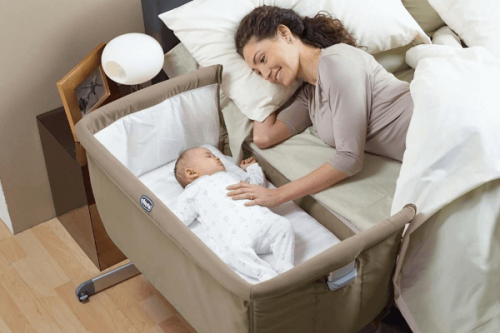5 Methods for Co-Sleeping With Your Baby

Contrary to what many people may think, there’s more than one way of co-sleeping with your baby. Placing your baby in your bed isn’t the only valid method.
For those who don’t know, co-sleeping is the decision to have children sleep along with parents in the same bed. There is a great deal of debate around this practice.
Those who support co-sleeping state that family bonding is one of the biggest benefits. Those who are against it often state that co-sleeping gets in the way of a couple’s sex life.
The good news is that “the family bed” offers various alternatives for couples with children. Making a decision will be much simpler once you discover the diverse options for co-sleeping.
The traditional method: Placing your baby in your bed
The most classic way to co-sleep consists of placing your baby on the parents’ mattress. Of course, this option presents a problem from the get-go. For safety reasons, the baby almost always sleeps between the two parents.
There are many parents who can and want to sleep this way. As long as both parents are in agreement, this is just fine. But it’s true that this arrangement can be challenging because the couple gives up their space of intimacy in order to share their bed.
However, when looking at co-sleeping from the perspective of warmth and family bonding, this is the most complete method. Despite differing opinions, there are other methods that also allow families to rest together during the night.

A bassinet next to the parents’ bed
Having your baby sleeping next to you, but not in the same bed, also falls into the category of co-sleeping. This method has its advantages.
Even though you’re a few more inches apart, your child is still sleeping with you. Whether your baby needs soothing or it’s time to feed, he or she will be within arm’s reach.
Since bassinets are low to the ground, they reduce the chances of your child having an accident. Nor is there any chance of rolling over onto your baby as there is if your baby sleeps in your bed.
However, you do need to practice extreme caution in one respect. Don’t place a bassinet so close to your bed that your own blankets or pillows could fall on top of your baby. Small babies lack the strength and reflexes to uncover their faces if a blanket or pillow obstructs their breathing.
Of course, this method is only useful during the first months of a baby’s life, given the small size of bassinets. Soon your baby will grow and become more active as well. It’s good to place pillows or bed spreads around the perimeter of the bassinet in case your baby crawls out.
“Those who support co-sleeping state that family bonding is one of the biggest benefits. Those who are against it often state that co-sleeping gets in the way of a couple’s sex life”
Innovative ways of co-sleeping with your baby: Co-sleeping cribs
What’s great about this method is that your baby will sleep right next to your bed and on the same level. All you need is a crib that allows you to uninstall or lower the side railings on one side. In fact, you can even purchase cribs that are designed for co-sleeping.
The idea is that you place the crib right next to your own bed without any separation or obstacles in the middle. This option gives parents easy access to their baby without having him or her in between them.
If the baby cries during the night or needs to nurse, parents can slide him onto their bed without even having to get up.
The baby on a mattress on the floor
This is an excellent option for parents who want to keep their baby safe while at the same time eliminating barriers. If your baby sleeps on a mattress on the floor, then there’s no danger of falling. Just the same, we recommend placing pillows or blanket on the floor around the mattress.
This alternative is best for children who are at least 3 years of age. At this point, they’re more autonomous and aware of their movements. This dynamic also helps contribute to your child’s sense of independence.

Why don’t we all sleep on the floor?
This is a great idea if you want to enjoy a unique family experience. To do so, you’ll need mattresses or sleeping bags. The only requirement is that the entire family sleep on floor level.
You can choose this method every once in a while as a way for your whole family to break from routine. Co-sleeping doesn’t necessarily have to be an everyday thing. It’s really up to the parents to decide.
As you can see, there are various ways to approach co-sleeping. The method will depend on the age of your child, your own preferences, and other variables as well. There’s no need to sleep far away from your child, or stick to one rigid method every night.
Contrary to what many people may think, there’s more than one way of co-sleeping with your baby. Placing your baby in your bed isn’t the only valid method.
For those who don’t know, co-sleeping is the decision to have children sleep along with parents in the same bed. There is a great deal of debate around this practice.
Those who support co-sleeping state that family bonding is one of the biggest benefits. Those who are against it often state that co-sleeping gets in the way of a couple’s sex life.
The good news is that “the family bed” offers various alternatives for couples with children. Making a decision will be much simpler once you discover the diverse options for co-sleeping.
The traditional method: Placing your baby in your bed
The most classic way to co-sleep consists of placing your baby on the parents’ mattress. Of course, this option presents a problem from the get-go. For safety reasons, the baby almost always sleeps between the two parents.
There are many parents who can and want to sleep this way. As long as both parents are in agreement, this is just fine. But it’s true that this arrangement can be challenging because the couple gives up their space of intimacy in order to share their bed.
However, when looking at co-sleeping from the perspective of warmth and family bonding, this is the most complete method. Despite differing opinions, there are other methods that also allow families to rest together during the night.

A bassinet next to the parents’ bed
Having your baby sleeping next to you, but not in the same bed, also falls into the category of co-sleeping. This method has its advantages.
Even though you’re a few more inches apart, your child is still sleeping with you. Whether your baby needs soothing or it’s time to feed, he or she will be within arm’s reach.
Since bassinets are low to the ground, they reduce the chances of your child having an accident. Nor is there any chance of rolling over onto your baby as there is if your baby sleeps in your bed.
However, you do need to practice extreme caution in one respect. Don’t place a bassinet so close to your bed that your own blankets or pillows could fall on top of your baby. Small babies lack the strength and reflexes to uncover their faces if a blanket or pillow obstructs their breathing.
Of course, this method is only useful during the first months of a baby’s life, given the small size of bassinets. Soon your baby will grow and become more active as well. It’s good to place pillows or bed spreads around the perimeter of the bassinet in case your baby crawls out.
“Those who support co-sleeping state that family bonding is one of the biggest benefits. Those who are against it often state that co-sleeping gets in the way of a couple’s sex life”
Innovative ways of co-sleeping with your baby: Co-sleeping cribs
What’s great about this method is that your baby will sleep right next to your bed and on the same level. All you need is a crib that allows you to uninstall or lower the side railings on one side. In fact, you can even purchase cribs that are designed for co-sleeping.
The idea is that you place the crib right next to your own bed without any separation or obstacles in the middle. This option gives parents easy access to their baby without having him or her in between them.
If the baby cries during the night or needs to nurse, parents can slide him onto their bed without even having to get up.
The baby on a mattress on the floor
This is an excellent option for parents who want to keep their baby safe while at the same time eliminating barriers. If your baby sleeps on a mattress on the floor, then there’s no danger of falling. Just the same, we recommend placing pillows or blanket on the floor around the mattress.
This alternative is best for children who are at least 3 years of age. At this point, they’re more autonomous and aware of their movements. This dynamic also helps contribute to your child’s sense of independence.

Why don’t we all sleep on the floor?
This is a great idea if you want to enjoy a unique family experience. To do so, you’ll need mattresses or sleeping bags. The only requirement is that the entire family sleep on floor level.
You can choose this method every once in a while as a way for your whole family to break from routine. Co-sleeping doesn’t necessarily have to be an everyday thing. It’s really up to the parents to decide.
As you can see, there are various ways to approach co-sleeping. The method will depend on the age of your child, your own preferences, and other variables as well. There’s no need to sleep far away from your child, or stick to one rigid method every night.
All cited sources were thoroughly reviewed by our team to ensure their quality, reliability, currency, and validity. The bibliography of this article was considered reliable and of academic or scientific accuracy.
- Landa Rivera, L., Díaz-Gómez, M., Gómez Papi, A., Paricio Talayero, J. M., Pallás Alonso, C., Hernández Aguilar, M. T., … & Lasarte Velillas, J. J. (2012). El colecho favorece la práctica de la lactancia materna y no aumenta el riesgo de muerte súbita del lactante: Dormir con los padres. Pediatría Atención Primaria, 14(53), 53-60. http://scielo.isciii.es/pdf/pap/v14n53/revision1.pdf
- Horsley T, Clifford T, Barrowman N, Bennett S, Yasdi F, Sampson M, et al. (2007). Benefits and harms associated with the practice of bed sharing. Arch Pediatr Ado- lesc Med. 2007;161:237-45.
- Martin Martin, R., Sanchez Bayle, M., & Teruel de Francisco, M. C. (2017). El colecho en nuestro medio: estudio de casos y controles en las consultas pediátricas de Atención Primaria. Pediatría Atención Primaria, 19(73), 15-21. http://scielo.isciii.es/scielo.php?script=sci_arttext&pid=S1139-76322017000100003
- Rodríguez Villar, V., Moreno, M., & Navío, C. PRACTICANDO EL COLECHO. ASESORAMIENTO DE LA MATRONA. http://www.trances.es/papers/TCS%2005_3_6.pdf
- Ball, H. L., Hooker, E., & Kelly, P. J. (2000). Parent–infant co‐sleeping: fathers’ roles and perspectives. Infant and Child Development: An International Journal of Research and Practice, 9(2), 67-74. https://onlinelibrary.wiley.com/doi/abs/10.1002/1522-7219(200006)9:2%3C67::AID-ICD209%3E3.0.CO;2-7
This text is provided for informational purposes only and does not replace consultation with a professional. If in doubt, consult your specialist.








